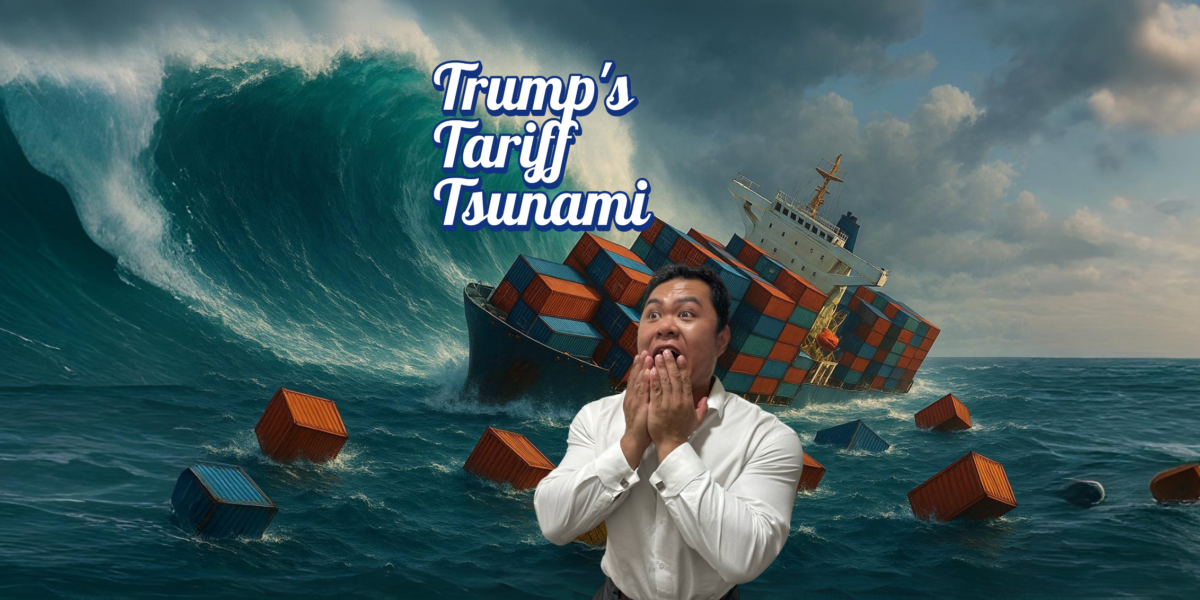If you haven’t heard the news — at the time of writing, the US President made a shocking twist and just announced a 90-day freeze on the heavy tariffs he slapped on dozens of countries… except China’s not on the guest list. In fact, the tariff on Chinese imports was just raised to a whopping 125%, up from 104% the day before.
This happened right after China hit back with 84% tariffs on US imports.
That said, during the freeze, the US’s “baseline” 10% tariff still applies to most countries.
So… what are tariffs and how do they work?
What are tariffs?
Basically, tariffs are taxes placed on goods imported from other countries. They’re usually charged as a percentage of the product’s value. For example, a 25% tariff on a $10 item means you’re paying an extra $2.50 in tax. Now imagine the new 125% tariff on Chinese goods — that same $10 product would now cost $22.50, because there’s an extra $12.50 slapped on top.
It’s not the shoppers who pay this tax directly though — it’s the companies that import the goods who have to pay it to the government. But let’s be real, they usually pass that cost down to us.

Why is Trump changing tariffs?
President Donald Trump is leveraging tariffs as part of his aggressive “reindustrialization” strategy to “make America great again,” aiming to boost U.S. manufacturing by making imported goods more expensive so that domestic goods can have a competitive edge. The goal is to help local businesses thrive. He believes that trade deficits harm the U.S. economy, and that imposing tariffs can help reset these imbalances and protect American industries.
Not just trade, but as a bargaining chip…
At the same time, Trump also used tariffs as a bargaining chip. He made demands to China, Mexico, and Canada, wanting them to do more to stop migrants and illegal drugs, like fentanyl, from reaching the US. In Feb 2025, he even slapped a 25% tariff on imports from Mexico and Canada to pressure them into action.

What are Trump’s ‘reciprocal tariffs’?
So, Trump and his team came up with something called a “reciprocal tariff.” Think of it like this — if another country is charging America a high price to sell our stuff in their country, then America will charge them the same high price to sell their stuff here. It’s like saying, “If you’re not playing fair, then I won’t either.”
Now, when we say “higher rates for countries that had significant trade surpluses with the U.S.,” here’s what that means:
Let’s pretend you keep trading toys with your friend. Every time, you give your friend 1 toy, but your friend gives you 10 toys. After a while, your toy box is overflowing, but your friend’s box is kinda empty. That’s what we call a trade surplus — your friend keeps sending you more stuff than they take from you. And you? You’ve got a trade deficit — you’re taking more than you’re giving.
Trump’s team said: “Hey, that’s not fair! If we’re buying way more from a country than they’re buying from us, we’ll charge them higher fees when they send stuff in.” So they made a formula — kind of like a recipe — to figure out how much each country should be charged, based on how big the difference is in how much we trade with each other.
So the more unfair the trade (in America’s eyes), the higher the tariff they set on that country’s goods. That’s why China, which sells a LOT to the US but doesn’t buy as much from us, got hit with one of the highest tariffs.

How do tariffs fair in reality?
Even though the reciprocal tariff is meant for countries that have a trade surplus with the US, some countries — including the UK — still had tariffs applied even though they actually buy more from the US than they sell to it.
Even Singapore, which benefits from a free trade agreement and charges 0% tariff on US products, is now facing a 10% default blanket tariff on their exports to the US.
Any goods that are exempt from tariffs?
The White House confirmed that some specific goods are exempt — including copper, pharmaceuticals, semiconductors, energy, and “other certain materials that are not available in the United States.”
Trump has also said he plans to remove the exemption for pharmaceutical goods to help shift drug production back to America, but it’s still unclear if or when that will happen.

How did other countries respond?
Different countries had different reactions when Trump raised tariffs — some fought back hard, others stayed calm, and a few tried to talk things out.
🔁 Countries That Retaliated
- China — After the U.S. raised tariffs on Chinese imports to 125%, China hit back with 84% tariffs on U.S. goods. They also blacklisted some major American companies.
- European Union (EU) — The EU clapped back too. They slapped new tariffs on U.S. goods like soybeans and oranges. Some went as high as 50%, trying to match the blow dollar-for-dollar.
- Canada — Canada matched the U.S. move with their own tariffs on American imports, going up to 25% on things like steel and aluminum.
🕊️ Countries That Did Not Retaliate
- Australia — Australia didn’t hit back. Even though they weren’t happy, they chose diplomacy instead. PM Anthony Albanese said, “this is not the act of a friend.”
- Indonesia — Indonesia also stayed cool. They said they wouldn’t retaliate and hoped things could be sorted through talks.
- Singapore – Singapore that benefits from a Free Trade Agreement (FTA) with the US — decided not to retaliate and continues to maintain a 0% tariff on US imports.
🤝 Countries That Tried to Negotiate
- Japan — Japan was hit with 24% tariffs. They quickly formed a special team to study the impact and started talks to bring the tariffs down.
- Vietnam — Vietnam faced a 46% tariff. They didn’t retaliate but said they were ready to negotiate.
- South Korea — South Korea’s Trade Minister Ahn Duk-geun went to Washington to negotiate. Acting President Han Duck-Soo said, “The global trade war has become a reality.”

How do tariffs affect the stock market?
Stock markets don’t like surprises — and tariffs? They’re a big one. When a new tariff is announced, especially one that targets major trading partners like China, it creates uncertainty. And when investors get nervous, they start selling.
For example, when Trump suddenly raised tariffs on China, the stock market dropped sharply because investors worried it would hurt global trade, slow down company profits, and drive up costs. But when he announced a 90-day freeze on tariffs for other countries, markets bounced back almost immediately. It was like a sigh of relief.
In short:
- More tariffs = more costs = lower profits for companies = stock prices fall
- Tariff freeze or trade peace = less worry = stock prices go up

What should you do about your investment?
With all the back-and-forth between countries and tariffs flying left and right, the market can get pretty wild. So what should you do if you’re an investor?
- Don’t panic Markets go up and down. Tariffs might shake things up in the short term, but panicking and selling everything usually causes more harm than good. Take a breath, zoom out, and look at the long-term picture.
- Diversify your investments Don’t put all your eggs in one basket. If you’re too heavy in one country (like China or the U.S.) or one sector (like manufacturing), a tariff can hit you hard. Spread your money across different industries and regions — so if one goes down, others might hold up.
- Focus on Dollar Cost Averaging Given the uncertainty, a dollar-cost averaging strategy is wise. It means investing small amounts regularly rather than trying to time the market. During COVID-19, for example, the bear market was steep and scary, but those who stayed consistent saw their portfolios bounce back stronger than ever.
- Have some cash ready If markets drop sharply, that could be a good time to pick up some good companies at a discount. But only if you’re ready and not overexposed.
Bonus tip: Sometimes the best thing you can do is nothing — just stick to your plan and don’t let the noise shake you.

So, what do you think? Will these tariffs really bring back more jobs to the US, or will they just make life more expensive for everyone? Let me know your thoughts!
And hey — if you’re wondering how to plan your finances or invest wisely during this season of uncertainty, drop me a DM. Let’s chat!

Brief Timeline of Trump’s Tariff Moves
Jan 20 – Trump takes office and says he’ll use tariffs to protect American workers. He also talks about starting a new agency called the External Revenue Service (not created yet).
Jan 26 – Threatens 25% tariffs on Colombia after they refused two U.S. flights carrying migrants. Colombia retaliates, then quickly backs down.
Feb 1 – Trump signs an executive order: 10% tariff on China, 25% on Mexico and Canada. Says it’s to deal with drugs and illegal immigration.
Feb 3 – Trump gives a 30-day pause on tariffs for Mexico and Canada while they try to meet his demands.
Feb 4 – 10% tariff on all Chinese goods kicks in. China hits back the same day with more duties and starts investigating U.S. companies.
Feb 10 – China adds 15% tariffs on U.S. coal, gas, oil, farm machines, and big cars. These start Feb 10.
Feb 13 – Trump announces his “reciprocal tariff” plan — saying if you charge us 20%, we’ll charge you 20% too.
Feb 25 – Trump wants to check if imported copper needs tariffs for national security reasons.
Mar 1 – Same thing, but this time for lumber and timber.
Mar 4 – 25% tariffs on Mexico and Canada imports begin. China tariffs go up to 20%.
Mar 5-6 – Trump gives U.S. automakers a 1-month break from Mexico and Canada tariffs. Canada and Mexico start pulling back on retaliations.
Mar 10 – China slaps 15% tariffs on U.S. chicken, pork, soybeans, and beef. Exemptions apply for goods already on the way.
Mar 12 – Trump raises steel and aluminum tariffs to 25%. EU prepares to fight back with their own list of U.S. products.
Mar 13 – Trump threatens 200% tariffs on EU wine and champagne if they target U.S. whiskey.
Mar 24 – Trump says countries that buy oil from Venezuela will be taxed 25% starting Apr
Mar 26 – 25% auto import tariffs are announced, starting with fully-built cars, then parts.
Apr 2 – Trump launches the full “reciprocal” tariff plan. 10% for everyone, higher for specific countries:
- China: 34%
- EU: 20%
- South Korea: 25%
- Japan: 24%
- Taiwan: 32%
Apr 3-4 – Auto tariffs begin. Canada matches with their own. China fires back with 34% tariffs and adds new export rules on rare earth materials.
Apr 7 – Trump threatens to raise tariffs by another 50% if China doesn’t back down by Apr 8.
Apr 9 – China proceeds with 84% tariffs. Trump responds by bumping China tariffs up to 125%.




